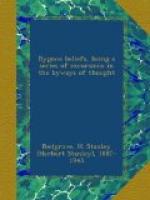The wonderful fabric of alchemical doctrine was not woven in a day, and as it passed from loom to loom, from Byzantium to Syria, from Syria to Arabia, from Arabia to Spain and Latin Europe, so its pattern changed; but it was always woven a priori, in the belief that that which is below is as that which is above. In its final form, I think, it is distinctly Christian.
In the Turba Philosophorum, the oldest known work of Latin alchemy—a work which, claiming to be of Greek origin, whilst not that, is certainly Greek in spirit,—we frequently come across statements of a decidedly mystical character. “The regimen,” we read, “is greater than is perceived by reason, except through divine inspiration."[1] Copper, it is insisted upon again and again, has a soul as well as a body; and the Art, we are told, is to be defined as “the liquefaction of the body and the separation of the soul from the body, seeing that copper, like a man, has a soul and a body."[2] Moreover, other doctrines are here propounded which, although not so obviously of a mystical character, have been traced to mystical sources in the preceding excursion. There is, for instance, the doctrine of purification by means of putrefaction, this process being likened to that of the resurrection of man. “These things being done,” we read, “God will restore unto it [the matter operated on] both the soul and the spirit thereof, and the weakness being taken away, that matter will be made strong, and after corruption will be improved, even as a man becomes stronger after resurrection and younger than he was in this world."[1b] The three stages in the alchemical work—black, white, and red—corresponding to, and, as I maintain, based on the three stages in the life of the mystic, are also more than once mentioned. “Cook them [the king and his wife], therefore, until they become black, then white, afterwards red, and finally until a tingeing venom is produced."[2b]
[1] The Turba Philosophorum, or Assembly of the Sages (trans. by A. E. WAITE, 1896), p. 128.
[2] Ibid., p. 193, cf. pp. 102 and 152.
[1b] The Turba Philosophorum, or Assembly of the Sages (trans. by A. E. WAITE), p. 101, cf. pp. 27 and 197.
[2b] Ibid., p. 98, cf. p. 29.
In view of these quotations, the alliance (shall I say?) between alchemy and mysticism cannot be asserted to be of late origin. And we shall find similar statements if we go further back in time. To give but one example: “Among the earliest authorities,” writes Mr WAITE, “the Book of Crates says that copper, like man, has a spirit, soul, and body,” the term “copper” being symbolical and applying to a stage in the alchemical work. But nowhere in the Turba do we meet with the concept of the Philosopher’s Stone as the medicine of the metals, a concept characteristic of Latin alchemy, and, to quote Mr WAITE again, “it does not appear that the conception of the Philosopher’s Stone as a medicine of metals and of men was familiar to Greek alchemy;"[3]




